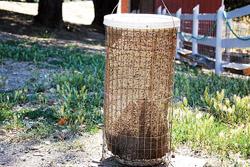 The name “Big Stinky” may not sound like a great fly removal solution, but it beats using pesticides, says Scott Bice, farm manager at Redwood Hill Farm & Creamery.
The name “Big Stinky” may not sound like a great fly removal solution, but it beats using pesticides, says Scott Bice, farm manager at Redwood Hill Farm & Creamery.
With 300 goats on 8 acres and lots of regular visitors, the Sebastopol, Calif., orchard operation feels it’s important to keep flies under control by organic means. The 15 to 20 3-ft. tall fly traps positioned around the farm have been doing a good job since an employee – nicknamed Mother Nature – came up with the design 25 years ago. The basic concept is to attract flies with bait and confuse them about how to get out of the cone inside the trap.
The fermented bait is key, says Bice. Whisk 1 1/4 cups dry baking yeast into a half-gallon of warm water. Add 1 heaping tablespoon of ammonium carbonate (used in baking and available through online stores). Pour into a gallon plastic bottle and cap with a vapor lock to allow gases to escape. Place in a warm location out of the sun, and let it age for a couple of days.
The bait is poured into a 9-in. disposable foil cake pan and slipped into the bottom of the trap, which is made of a piece of 24 by 36-in. long, 1 by 2-in. welded wire with a cone inside made of 30 by 42-in. aluminum mesh window screen.
A blog posting (Mother Nature’s Fly Trap) on the Redwood Hill Farm website explains how to build the trap so it’s tight enough that flies can’t escape, yet leaves room for flies to enter at the bottom, lured by the bait.
“The top of the trap is a 5-gal. bucket lid with a 2-in. hole in the center covered with acrylic plastic,” Bice explains. “It lets light in so the flies are attracted to the warmth and light. They can’t figure out to go back down to get out.”
It’s important to keep the acrylic piece clean so light can get through. You also have to keep the bait moist. Workers at the farm routinely remove the dead flies and feed them to the chickens.
The trap doesn’t attract good insects, Bice says. But it does attract yellow jackets in the fall.
“My guess is that they are carnivorous, so they are going after the flies,” he says.
Employees have made miniature versions to hang in olive trees to capture fruit flies, using similar bait.
“This trap would work in backyards, where people are composting, where there is wet waste - any place where there are flies,” he says. “It doesn’t get them all, but it knocks down the numbers of them, especially if you set the traps out in the early spring.”
1-800-834-9665
“Big Stinky” Traps Flies Chemical-Free
FARM SHOW Magazine » “Big Stinky” Traps Flies Chemical-Free
“Big Stinky” Traps Flies Chemical-Free
